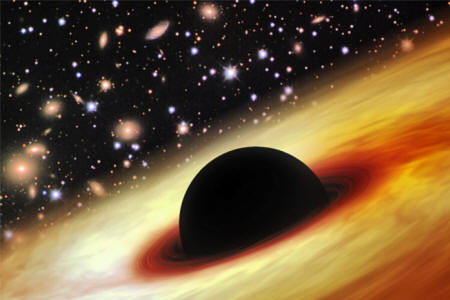|

by Davide Castelvecchi
25 February 2015
from
Nature Website

An artist’s
impression of a quasar
with a supermassive
black hole at its heart
in the distant
Universe.
Super-massive object found in
early Universe
tests theories of cosmic
evolution.
A black hole that grew to
gargantuan size in the Universe's first billion years is by far the
largest yet spotted from such an early date, researchers have
announced.
The object, discovered by astronomers in
2013, is 12 billion times as massive as the Sun, and six
times greater than its largest-known contemporaries. Its
existence poses a challenge for theories of the evolution of black
holes, stars and galaxies, astronomers say.
Light from the black hole took 12.9 billion years to reach Earth, so
astronomers see the object as it was 900 million years after the Big
Bang. That "is actually a very short time" for a black hole to have
grown so large, says astronomer Xue-Bing Wu of Peking
University in Beijing.
He led an international collaboration
that describes the discovery in Nature.1
For its age, this black hole,
"is really much more massive than
anything else we have seen so far", says Christian Veillet,
director of the Large Binocular Telescope Observatory in Tucson,
Arizona.
Light sink
Wu and his colleagues spotted the black hole using the Lijiang
Telescope in Yunnan, China. The object appeared as a bright, red,
point-like source.
The brightness and spectrum of its light
revealed it to be an ancient quasar:
a large black hole that occupies the
centre of a galaxy and causes interstellar gas to overheat and
shine brighter than any star as it spirals into the hole's
gravitational sink.
The team analyzed the quasar's spectrum
in more detail - an effort that eventually involved four larger
telescopes around the world - to estimate the velocity of the
infalling gas.
This revealed the strength of the
object’s gravity, and hence its unusually large mass.
Supermassive black holes are thought to lurk at the centre of most
galaxies, and some have been seen that are as many as 40 billion
times the mass of the Sun. 2
But reaching such sizes involves
swallowing interstellar matter and merging with other large black
holes, so it takes time. Until now, the most massive known black
hole less than 1 billion years old was around 2 billion solar
masses.3
One possible explanation, says Chris Willott, an astronomer
at the Canadian Astronomy Data Centre in Victoria, is that some
black holes could begin their lives not with the gravitational
collapse of a single star, but with the direct collapse of a very
large gas cloud.
"We are still very uncertain as to
the modes of black-hole formation and growth in the early
Universe," he says, "so we do not have a leading model for this
observation to pose problems to."
Wu's team now plans to make follow-up
observations, including some using the Hubble Space Telescope.
References
-
Wu, X.-B. et al. Nature 518,
512–515 (2015) -
An ultraluminous quasar with a
twelve-billion-solar-mass black hole at redshift 6.30
-
Ghisellini, G. et al. Mon. Not.
R. Astron. Soc. 399, L24–L28 (2009) -
The blazar S5 0014+813: a real or
apparent monster?
-
Mortlock, D. J. et al. Nature
474, 616–619 (2011) -
A luminous quasar at a redshift of z = 7.085
|

